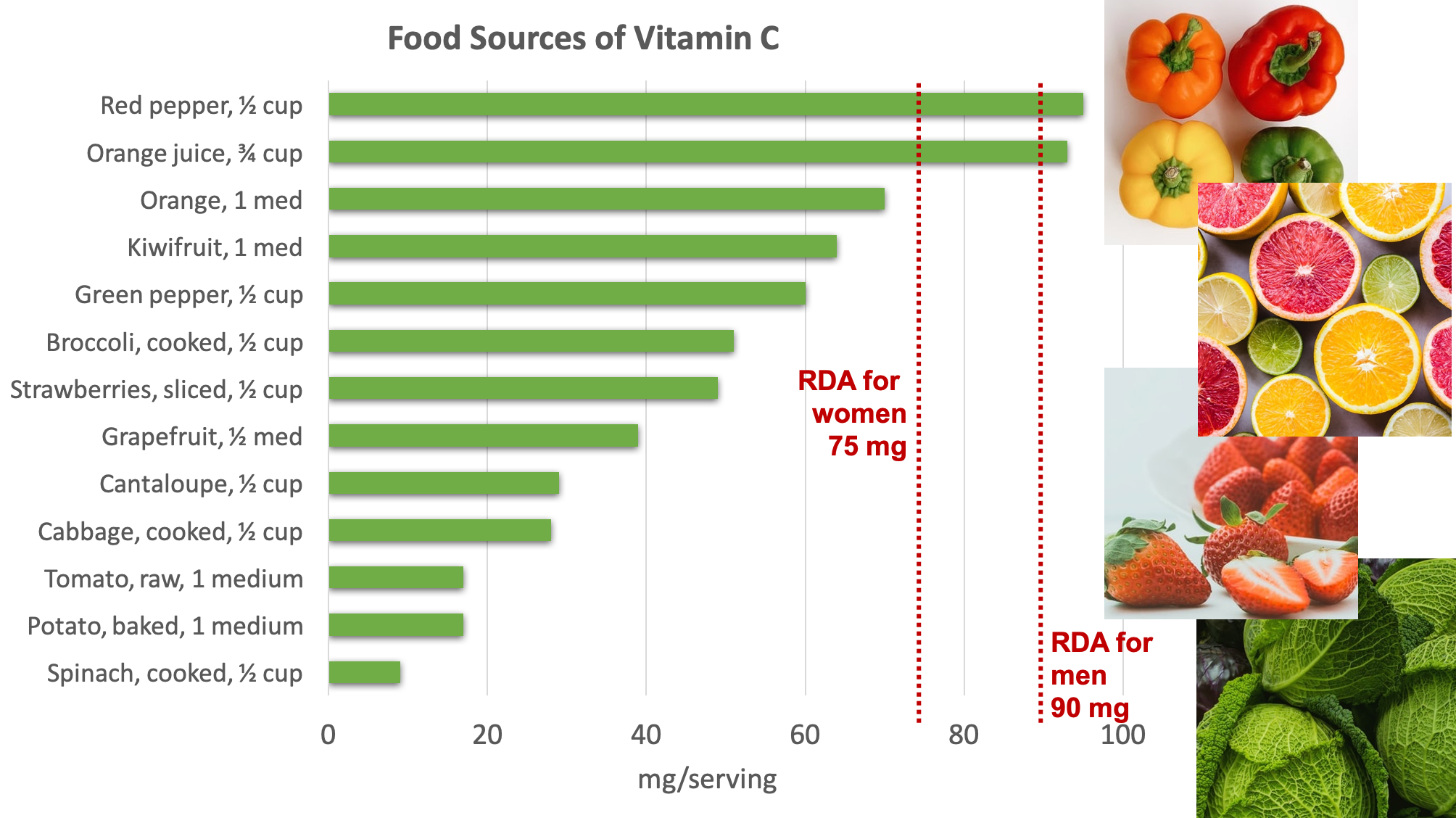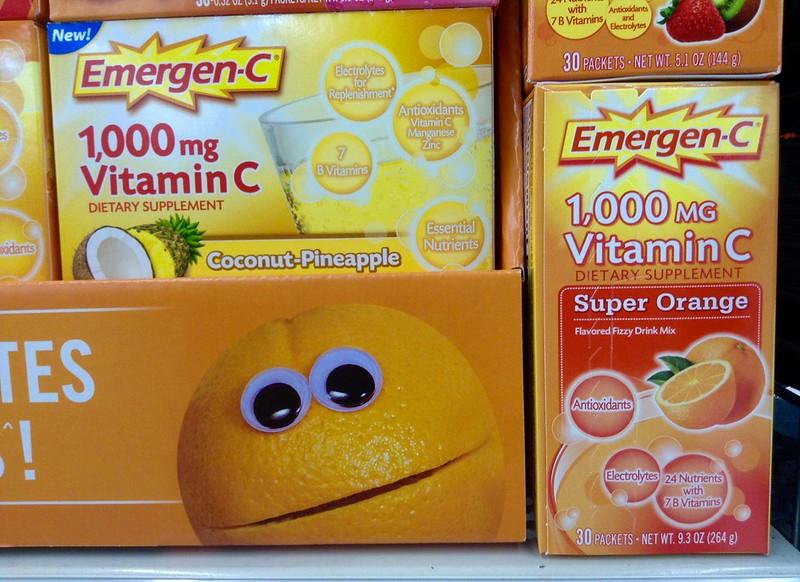12.4: Vitamin C
- Page ID
- 44449
\( \newcommand{\vecs}[1]{\overset { \scriptstyle \rightharpoonup} {\mathbf{#1}} } \)
\( \newcommand{\vecd}[1]{\overset{-\!-\!\rightharpoonup}{\vphantom{a}\smash {#1}}} \)
\( \newcommand{\id}{\mathrm{id}}\) \( \newcommand{\Span}{\mathrm{span}}\)
( \newcommand{\kernel}{\mathrm{null}\,}\) \( \newcommand{\range}{\mathrm{range}\,}\)
\( \newcommand{\RealPart}{\mathrm{Re}}\) \( \newcommand{\ImaginaryPart}{\mathrm{Im}}\)
\( \newcommand{\Argument}{\mathrm{Arg}}\) \( \newcommand{\norm}[1]{\| #1 \|}\)
\( \newcommand{\inner}[2]{\langle #1, #2 \rangle}\)
\( \newcommand{\Span}{\mathrm{span}}\)
\( \newcommand{\id}{\mathrm{id}}\)
\( \newcommand{\Span}{\mathrm{span}}\)
\( \newcommand{\kernel}{\mathrm{null}\,}\)
\( \newcommand{\range}{\mathrm{range}\,}\)
\( \newcommand{\RealPart}{\mathrm{Re}}\)
\( \newcommand{\ImaginaryPart}{\mathrm{Im}}\)
\( \newcommand{\Argument}{\mathrm{Arg}}\)
\( \newcommand{\norm}[1]{\| #1 \|}\)
\( \newcommand{\inner}[2]{\langle #1, #2 \rangle}\)
\( \newcommand{\Span}{\mathrm{span}}\) \( \newcommand{\AA}{\unicode[.8,0]{x212B}}\)
\( \newcommand{\vectorA}[1]{\vec{#1}} % arrow\)
\( \newcommand{\vectorAt}[1]{\vec{\text{#1}}} % arrow\)
\( \newcommand{\vectorB}[1]{\overset { \scriptstyle \rightharpoonup} {\mathbf{#1}} } \)
\( \newcommand{\vectorC}[1]{\textbf{#1}} \)
\( \newcommand{\vectorD}[1]{\overrightarrow{#1}} \)
\( \newcommand{\vectorDt}[1]{\overrightarrow{\text{#1}}} \)
\( \newcommand{\vectE}[1]{\overset{-\!-\!\rightharpoonup}{\vphantom{a}\smash{\mathbf {#1}}}} \)
\( \newcommand{\vecs}[1]{\overset { \scriptstyle \rightharpoonup} {\mathbf{#1}} } \)
\( \newcommand{\vecd}[1]{\overset{-\!-\!\rightharpoonup}{\vphantom{a}\smash {#1}}} \)
\(\newcommand{\avec}{\mathbf a}\) \(\newcommand{\bvec}{\mathbf b}\) \(\newcommand{\cvec}{\mathbf c}\) \(\newcommand{\dvec}{\mathbf d}\) \(\newcommand{\dtil}{\widetilde{\mathbf d}}\) \(\newcommand{\evec}{\mathbf e}\) \(\newcommand{\fvec}{\mathbf f}\) \(\newcommand{\nvec}{\mathbf n}\) \(\newcommand{\pvec}{\mathbf p}\) \(\newcommand{\qvec}{\mathbf q}\) \(\newcommand{\svec}{\mathbf s}\) \(\newcommand{\tvec}{\mathbf t}\) \(\newcommand{\uvec}{\mathbf u}\) \(\newcommand{\vvec}{\mathbf v}\) \(\newcommand{\wvec}{\mathbf w}\) \(\newcommand{\xvec}{\mathbf x}\) \(\newcommand{\yvec}{\mathbf y}\) \(\newcommand{\zvec}{\mathbf z}\) \(\newcommand{\rvec}{\mathbf r}\) \(\newcommand{\mvec}{\mathbf m}\) \(\newcommand{\zerovec}{\mathbf 0}\) \(\newcommand{\onevec}{\mathbf 1}\) \(\newcommand{\real}{\mathbb R}\) \(\newcommand{\twovec}[2]{\left[\begin{array}{r}#1 \\ #2 \end{array}\right]}\) \(\newcommand{\ctwovec}[2]{\left[\begin{array}{c}#1 \\ #2 \end{array}\right]}\) \(\newcommand{\threevec}[3]{\left[\begin{array}{r}#1 \\ #2 \\ #3 \end{array}\right]}\) \(\newcommand{\cthreevec}[3]{\left[\begin{array}{c}#1 \\ #2 \\ #3 \end{array}\right]}\) \(\newcommand{\fourvec}[4]{\left[\begin{array}{r}#1 \\ #2 \\ #3 \\ #4 \end{array}\right]}\) \(\newcommand{\cfourvec}[4]{\left[\begin{array}{c}#1 \\ #2 \\ #3 \\ #4 \end{array}\right]}\) \(\newcommand{\fivevec}[5]{\left[\begin{array}{r}#1 \\ #2 \\ #3 \\ #4 \\ #5 \\ \end{array}\right]}\) \(\newcommand{\cfivevec}[5]{\left[\begin{array}{c}#1 \\ #2 \\ #3 \\ #4 \\ #5 \\ \end{array}\right]}\) \(\newcommand{\mattwo}[4]{\left[\begin{array}{rr}#1 \amp #2 \\ #3 \amp #4 \\ \end{array}\right]}\) \(\newcommand{\laspan}[1]{\text{Span}\{#1\}}\) \(\newcommand{\bcal}{\cal B}\) \(\newcommand{\ccal}{\cal C}\) \(\newcommand{\scal}{\cal S}\) \(\newcommand{\wcal}{\cal W}\) \(\newcommand{\ecal}{\cal E}\) \(\newcommand{\coords}[2]{\left\{#1\right\}_{#2}}\) \(\newcommand{\gray}[1]{\color{gray}{#1}}\) \(\newcommand{\lgray}[1]{\color{lightgray}{#1}}\) \(\newcommand{\rank}{\operatorname{rank}}\) \(\newcommand{\row}{\text{Row}}\) \(\newcommand{\col}{\text{Col}}\) \(\renewcommand{\row}{\text{Row}}\) \(\newcommand{\nul}{\text{Nul}}\) \(\newcommand{\var}{\text{Var}}\) \(\newcommand{\corr}{\text{corr}}\) \(\newcommand{\len}[1]{\left|#1\right|}\) \(\newcommand{\bbar}{\overline{\bvec}}\) \(\newcommand{\bhat}{\widehat{\bvec}}\) \(\newcommand{\bperp}{\bvec^\perp}\) \(\newcommand{\xhat}{\widehat{\xvec}}\) \(\newcommand{\vhat}{\widehat{\vvec}}\) \(\newcommand{\uhat}{\widehat{\uvec}}\) \(\newcommand{\what}{\widehat{\wvec}}\) \(\newcommand{\Sighat}{\widehat{\Sigma}}\) \(\newcommand{\lt}{<}\) \(\newcommand{\gt}{>}\) \(\newcommand{\amp}{&}\) \(\definecolor{fillinmathshade}{gray}{0.9}\)Vitamin C
Vitamin C, also called ascorbic acid, is a water-soluble vitamin essential in the diet for humans. Interestingly, most other mammals can readily synthesize vitamin C and don’t require it in their diets. Vitamin C’s ability to easily donate electrons makes it a highly effective antioxidant. Since it is water-soluble, it acts both inside and outside cells to protect molecules in aqueous environments. Vitamin C also plays a vital role in regenerating vitamin E after it has acted as an antioxidant, allowing it to be recycled and used again.

Figure 8.15. After vitamin E donates an electron to neutralize a free radical, it can be regenerated by an electron from vitamin C. Vitamin C is then regenerated by antioxidant enzymes.
In addition to its role as an antioxidant, vitamin C is a required part of several enzymes involved in the synthesis of collagen, a protein important to the strength and structure of muscles, bones, tendons, ligaments, connective tissue, and skin. Vitamin C is also required to synthesize neurotransmitters important for signaling in the brain, some hormones, and amino acids. It also plays a role in immune function and improves the absorption of dietary iron.
The body’s vitamin C status is tightly controlled to maintain steady tissue and plasma concentrations. This means that if you consume high doses of vitamin C, you’ll absorb less from the intestine and excrete more in urine to prevent excessive concentrations in the body. Vitamin C is not stored in any significant amount in the body, but once it has reduced a free radical, it is very effectively regenerated and therefore can exist in the body as a functioning antioxidant for many weeks.
Food Sources of Vitamin C

Figure 8.16. Dietary sources of vitamin C. Source: NIH Office of Dietary Supplements
Because vitamin C is water-soluble, it leaches away from foods considerably during cooking, freezing, thawing, and canning. Up to 50% of vitamin C can be boiled away. Therefore, eating fruits and vegetables raw or lightly steamed maximizes the vitamin C value of these foods.
Vitamin C Deficiency and Toxicity
The classic condition caused by vitamin C deficiency is scurvy. The signs and symptoms of scurvy include skin disorders, bleeding gums, joint pain, and weakness—all of which may be related to vitamin C’s role in collagen synthesis. Additional symptoms of scurvy include abnormally-thickened skin, fatigue, depression, iron deficiency anemia, and increased susceptibility to infections.
In the past, scurvy was common among sailors on long ocean voyages, whose diets were completely lacking in fruits and vegetables for many months. In the mid-1700s, British Navy surgeon Sir James Lind’s experiments revealed that citrus fruits and juices could prevent scurvy in sailors. British sailors were often referred to as “limeys,” as they carried sacks of limes onto ships to prevent scurvy. It was not until 1932 that scientists showed that vitamin C was the essential nutrient involved in this cure.

Scurvy is prevented by even a low intake of fruits and vegetables, and it takes at least a month of consuming very little or no vitamin C for scurvy symptoms to develop. Thus, scurvy is rare in developed countries today. Diet surveys show that most Americans meet the RDA for vitamin C. When vitamin C deficiency occurs today, it is in people who consume very limited food variety, such as those with mental illness, people who abuse alcohol or drugs, people on very restrictive diets, and impoverished people with limited fruit and vegetable access. People who smoke also require more vitamin C to counter the free radicals generated by smoking.
The risk of vitamin C toxicity from foods is essentially nonexistent, because the body can adjust intestinal absorption and urinary excretion to maintain a healthy vitamin C level. However, high doses of vitamin C from supplements have been reported to cause numerous problems, including gastrointestinal upset and diarrhea. To prevent these discomforts, the UL for vitamin C is set at 2,000 milligrams per day for adults, more than twenty times the RDA.
At very high doses in combination with iron, vitamin C has sometimes been found to increase oxidative stress, reaffirming that getting your antioxidants from foods is better than getting them from supplements. There is also some evidence that taking vitamin C supplements at high doses increases the likelihood of developing kidney stones; however, this effect is most often observed in people that already have multiple risk factors for kidney stones.
Can Vitamin C Supplements Prevent the Common Cold?
Many people believe that taking a vitamin C supplement can prevent the common cold or decrease its symptoms. This idea was popularized by Linus Pauling in the 1970s, and it’s continuously promoted today in the form of over-the-counter supplements such as Emergen-C and Airborne. These typically contain doses in the range of 1000 mg of vitamin C, far higher than normal levels of vitamin C in the diet and enough to reach the UL of 2000 mg if a person takes two doses per day.

Vitamin C Functions and Health Benefits
Vitamin C, also commonly called ascorbic acid, is a water-soluble micronutrient essential in the diet for humans, although most other mammals can readily synthesize it. Vitamin C’s ability to easily donate electrons makes it a highly effective antioxidant. It is effective in scavenging reactive oxygen species, reactive nitrogen species, and many other free radicals. It protects lipids both by disabling free radicals and by aiding in the regeneration of vitamin E.
In addition to its role as an antioxidant, vitamin C is a required part of several enzymes involved in the synthesis of collagen, signaling molecules in the brain, some hormones, and amino acids. Vitamin C levels in the body are affected by the amount in the diet, which influences how much is absorbed and how much the kidney allows to be excreted, such that the higher the intake, the more vitamin C is excreted. Vitamin C is not stored in any significant amount in the body, but once it has reduced a free radical, it is very effectively regenerated and therefore it can exist in the body as a functioning antioxidant for many weeks.
Cardiovascular Disease
Vitamin C’s ability to prevent disease has been debated for many years. Overall, higher dietary intakes of vitamin C (via food intake, not supplements), are linked to decreased disease risk. A review of multiple studies published in the April 2009 issue of the Archives of Internal Medicine concludes there is moderate scientific evidence supporting the idea that higher dietary vitamin C intakes are correlated with reduced cardiovascular disease risk, but there is insufficient evidence to conclude that taking vitamin C supplements influences cardiovascular disease risk.Mente, A., et al. “A Systematic Review of the Evidence Supporting a Causal Link between Dietary Factors and Coronary Heart Disease.” Arch Intern Med 169, no.7 (2009): 659–69. archinte.ama-assn.org/cgi/content/full/169/7/659.
Vitamin C levels in the body have been shown to correlate well with fruit and vegetable intake, and higher plasma vitamin C levels are linked to reduced risk of some chronic diseases. In a study involving over twenty thousand participants, people with the highest levels of circulating vitamin C had a 42 percent decreased risk for having a stroke.Myint, P.K. et al. “Plasma Vitamin C Concentrations Predict Risk of Incident Stroke Over 10 Y[ears] in 20,649 Participants of the European Prospective Investigation into Cancer, Norfolk Prospective Population Study.” Am J Clin Nutr 87, no.1 (2008): 64–69. http://www.ajcn.org/content/87/1/64.long.
Cancer
There is some evidence that a higher vitamin C intake is linked to a reduced risk of cancers of the mouth, throat, esophagus, stomach, colon, and lung, but not all studies confirm this is true. As with the studies on cardiovascular disease, the reduced risk of cancer is the result of eating foods rich in vitamin C, such as fruits and vegetables, not from taking vitamin C supplements. In these studies, the specific protective effects of vitamin C cannot be separated from the many other beneficial chemicals in fruits and vegetables.
Immunity
Vitamin C does have several roles in the immune system, and many people increase vitamin C intake either from diet or supplements when they have a cold. Many others take vitamin C supplements routinely to prevent colds. Contrary to this popular practice, however, there is no good evidence that vitamin C prevents a cold. A review of more than fifty years of studies published in 2004 in the Cochrane Database of Systematic Reviews concludes that taking vitamin C routinely does not prevent colds in most people, but it does slightly reduce cold severity and duration. Moreover, taking megadoses (up to 4 grams per day) at the onset of a cold provides no benefits.Douglas, R.M. et al. “Vitamin C for Preventing and Treating the Common Cold.” Cochrane Database of Systematic Reviews 4 (2004): CD000980. http://www.ncbi.nlm.nih.gov/pubmed/15495002?dopt=Abstract.
Gout is a disease caused by elevated circulating levels of uric acid and is characterized by recurrent attacks of tender, hot, and painful joints. There is some evidence that a higher intake of vitamin C reduces the risk of gout.
Dietary Reference Intakes for Vitamin C
The classic condition associated with vitamin C deficiency is scurvy. The signs and symptoms of scurvy include skin disorders, bleeding gums, painful joints, weakness, depression, and increased susceptibility to infections. Scurvy is prevented by having an Adequate Intake of fruits and vegetables rich in vitamin C.
The RDAs and ULs for different age groups for vitamin C are listed in Table \(\PageIndex{4}\). They are considered adequate to prevent scurvy. Vitamin C’s effectiveness as a free radical scavenger motivated the Institute of Medicine (IOM) to increase the RDA for smokers by 35 milligrams, as tobacco smoke is an environmental and behavioral contributor to free radicals in the body.
| Age Group | RDA Males and Females mg/day | UL |
|---|---|---|
| Infants (0–6 months) | 40* | – |
| Infants (7–12 months) | 50* | – |
| Children (1–3 years) | 15 | 400 |
| Children (4–8 years) | 25 | 650 |
| Children (9–13 years) | 45 | 1200 |
| Adolescents (14–18 years) | 75 (males), 65 (females) | 1800 |
| Adults (> 19 years) | 90 (males), 75 (females) | 2000 |
| *denotes Adequate Intake | ||
Source: National Institutes of Health, Office of Dietary Supplements. “Dietary Supplement Fact Sheet: Vitamin C.” Last reviewed June 24, 2011. http://ods.od.nih.gov/factsheets/VitaminC-QuickFacts/.
High doses of vitamin C have been reported to cause numerous problems, but the only consistently shown side effects are gastrointestinal upset and diarrhea. To prevent these discomforts the IOM has set a UL for adults at 2,000 milligrams per day (greater than twenty times the RDA).
At very high doses in combination with iron, vitamin C has sometimes been found to increase oxidative stress, reaffirming that getting your antioxidants from foods is better than getting them from supplements, as that helps regulate your intake levels. There is some evidence that taking vitamin C supplements at high doses increases the likelihood of developing kidney stones, however, this effect is most often observed in people that already have multiple risk factors for kidney stones.
Dietary Sources of Vitamin C
Citrus fruits are great sources of vitamin C and so are many vegetables. In fact, British sailors in the past were often referred to as “limeys” as they carried sacks of limes onto ships to prevent scurvy. Vitamin C is not found in significant amounts in animal-based foods.
Because vitamin C is water soluble, it leaches away from foods considerably during cooking, freezing, thawing, and canning. Up to 50 percent of vitamin C can be boiled away. Therefore, to maximize vitamin C intake from foods, you should eat fruits and vegetables raw or lightly steamed. For the vitamin C content of various foods, see Table \(\PageIndex{5}\).
| Food | Serving | Vitamin C (mg) |
|---|---|---|
| Orange juice | 6 oz. | 62–93 |
| Grapefruit juice | 6 oz. | 62–70 |
| Orange | 1 medium | 70 |
| Grapefruit | ½ medium | 38 |
| Strawberries | 1 c. | 85 |
| Tomato | 1 medium | 16 |
| Sweet red pepper | ½ c. raw | 95 |
| Broccoli | ½ c. cooked | 51 |
| Asparagus | 1 c. cooked | 20 |
| Romaine lettuce | 2 c. | 27 |
| Kale | 1 c. boiled | 53 |
| Cauliflower | 1 c. boiled | 55 |
| Potato | 1 medium, baked | 17 |
Source: National Institutes of Health, Office of Dietary Supplements. “Dietary Supplement Fact Sheet: Vitamin C.” Last reviewed June 24, 2011. http://ods.od.nih.gov/factsheets/VitaminC-HealthProfessional/.
Attributions
- Oregon
- Hawaii

